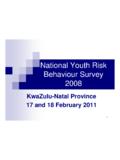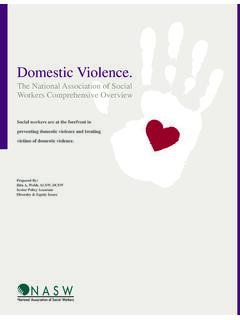Transcription of College Drinking Fact Sheet
1 NIH .. Turning Discovery Into Health National Institute on Alcohol Abuse and Institute on Alcohol Abuse and AlcoholismCollege DrinkingHarmful and underage College Drinking are significant public health problems, and they exact an enormous toll on the intellectual and social lives of students on campuses across the United States. Drinking at College has become a ritual that students often see as an integral part of their higher education experience. Many students come to College with established Drinking habits, and the College environment can exacerbate the problem. According to a national survey, almost 60 percent of College students ages 18 22 drank alcohol in the past month,1 and almost 2 out of 3 of them engaged in binge Drinking during that same of Harmful and Underage College DrinkingDrinking affects College students, their families, and College communities at large.
2 Researchers estimate that each year:DeathAbout 1,825 College students between the ages of 18 and 24 die from alcohol-related unintentional injuries, including motor-vehicle About 696,000 students between the ages of 18 and 24 are assaulted by another student who has been AssaultAbout 97,000 students between the ages of 18 and 24 report experiencing alcohol-related sexual assault or date is binge Drinking ? Many College alcohol problems are related to binge Drinking . Binge Drinking is a pattern of Drinking that brings blood alcohol concentration (BAC) levels to g/dL. This typically occurs after 4 drinks for women and 5 drinks for men in about 2 this way can pose serious health and safety risks, including car crashes, drunk-driving arrests, sexual assaults, and injuries.
3 Over the long term, frequent binge Drinking can damage the liver and other .. Turning Discovery Into Health National Institute on Alcohol Abuse and Alcoholism w w Academic Problems About 1 in 4 College students report academic consequences from Drinking , including missing class, falling behind in class, doing poorly on exams or papers, and receiving lower grades In a national survey of College students, binge drinkers who consumed alcohol at least 3 times per week were roughly 6 times more likely than those who drank but never binged to perform poorly on a test or project as a result of Drinking (40 percent vs.)
4 7 percent) and 5 times more likely to have missed a class (64 percent vs. 12 percent).6 Alcohol Use Disorder (AUD) About 20 percent of College students meet the criteria for an Other Consequences These include suicide attempts, health problems, injuries, unsafe sex, and driving under the influence of alcohol, as well as vandalism, property damage, and involvement with the police. Factors Affecting Student Drinking Although the majority of students come to College already having some experience with alcohol, certain aspects of College life, such as unstructured time, the widespread availability of alcohol, inconsistent enforcement of underage Drinking laws, and limited interactions with parents and other adults, can intensify the problem.
5 In fact , College students have higher binge- Drinking rates and a higher incidence of driving under the influence of alcohol than their non- College peers. The first 6 weeks of freshman year are a vulnerable time for heavy Drinking and alcohol-related consequences because of student expectations and social pressures at the start of the academic year. How much is a drink? To avoid binge Drinking and its consequences, College students (and all people who drink) are advised to track the number of drinks they consume over a given period of time. That is why it is important to know exactly what counts as a drink.
6 In the United States, a standard drink is one that contains about 14 grams of pure alcohol, which is found in: 12 ounces of beer with 5 percent alcohol content 5 ounces of wine with 12 percent alcohol content ounces of distilled spirits with 40 percent alcohol content Unfortunately, although the standard drink amounts are helpful for following health guidelines, they may not reflect customary serving sizes. A large cup of beer, an overpoured glass of wine, or a single mixed drink could contain much more alcohol than a standard drink. In addition, while the alcohol concentrations listed are typical, there is considerable variability in alcohol content within each type of beverage ( , beer, wine, distilled spirits).
7 NIH .. Turning Discovery Into Health National Institute on Alcohol Abuse and Alcoholism w w Factors related to specific College environments also are significant. Students attending schools with strong Greek systems and with prominent athletic programs tend to drink more than students at other types of schools. In terms of living arrangements, alcohol consumption is highest among students living in fraternities and sororities and lowest among commuting students who live with their families. An often-overlooked preventive factor involves the continuing influence of parents. Research shows that students who choose not to drink often do so because their parents discussed alcohol use and its adverse consequences with them.
8 Addressing College Drinking Ongoing research continues to improve our Alcohol poisoning and College understanding of how to address the persistent and students costly problem of harmful and underage student Drinking . Successful efforts typically involve a mix of strategies that Thousands of College students are transported to the emergency room target individual students, the student body as a whole, each year for alcohol poisoning, and the broader College community. which occurs when high levels of alcohol suppress the nervous Strategies Targeting Individual Students and respiratory systems and the Individual-level interventions target students, body struggles to rid itself of toxins including those in higher-risk groups such as first- produced from the breakdown of year students, student athletes, members of Greek alcohol.
9 Signs of this dangerous condition can include: organizations, and mandated students. They are designed to change students knowledge, attitudes, Mental confusion, stupor, coma, and behaviors related to alcohol so that they drink or the person cannot be roused less, take fewer risks, and experience fewer harmful Vomiting consequences. Categories of individual-level Slow or irregular breathing interventions include: Hypothermia or low body Education and awareness programs temperature, bluish or pale skin Cognitive behavioral skills-based approaches Alcohol poisoning can lead to permanent brain damage or death, so Motivation and feedback-related approaches a person showing any of these signs Behavioral interventions by requires immediate medical attention.
10 Health professionals Don t wait. Call 911 if you suspect alcohol poisoning. Strategies Targeting the Campus and Surrounding Community Environmental-level strategies target the campus community and student body as a whole, and are designed to change the campus and community environments in which student Drinking occurs. Often, a major goal is to reduce the availability of alcohol, because research shows that reducing alcohol availability cuts consumption and harmful consequences on campuses as well as in the general population. NIH .. Turning Discovery Into Health National Institute on Alcohol Abuse and Alcoholism December 2015 National Institute on Alcohol Abuse and Alcoholism A Mix of Strategies Is Best For more information on individual- and environmental-level strategies, the NIAAA CollegeAIM guide (and interactive Web site) rates nearly 60 alcohol interventions in terms of effectiveness, costs, and other factors and presents the information in a user-friendly and accessible way.






